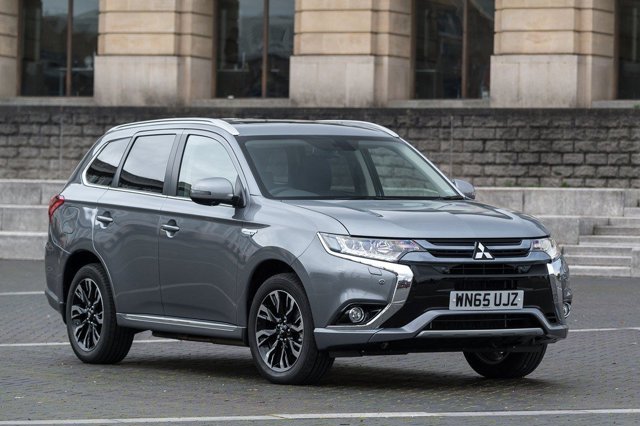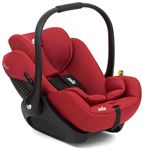17-03-2015:
Complaint of a clip inside the charger door of Outlander PHEV coming off, and getting stuck causing the door to be bent and a slight chip on the bodywork.
12-08-2015:
Reader quoted £7800 by Mitsubishi dealer to replace the satnav in a 2014 Outlander after a passenger accidentally cracked the screen.
14-08-2015:
Complaint that hybrid battery range of Outlander PHEV bought new March 2015 has dropped from 32 miles to less than 20 miles in four months. Car used mainly for local runs up to 20 miles, so mostly on battery on plug in charge.
27-03-2016:
Another complaint of clip inside the charger flap of a year old Mitsubishi Outlander PHEV coming off and the flap not closing properly. Clip replaced by dealer but came off again. Flap now rubs on the bodywork.
27-03-2016:
Complaint that headlights of 2015 Mitsubishi Outlander PHEV set too high and adjustment switch removed as a pre-delivery enhancement so they cannot be adjusted down.
27-03-2016:
Report that 2015 Mitsubishi Outlander PHEV at 9600 miles has lost its capacity to hold a full charge, down from 29/30 to 19/22.
01-02-2018:
Report of rear n/s brake caliper of 2014 Mitsubishi Outlander PHEV needing to be replaced in 2017 after the handbrake became ineffective and a seized self adjusting mechanism was diagnosed. Recently the same has happened on the off-side.
30-05-2018:
Failed parking brakes reported on recently purchased Mitsubishi Outlander PHEV. Dealer fixed the problem.
28-07-2018:
Report of front brake callipers seizing, damaging the pads and discs of 2014 Mitsubishi Outlander at 33,000 miles. Dealer fitted new pads and discs, but 9 months and 4000 miles later same thing happend and dealer now says customer must pay for new pads, discs and callipers.
21-07-2019:
Report of problem with charger of 2015 Mitsubishi Outlander PHEV at 21,790 miles, just after fourth dealer service. Owner plugged the charger in and had a fault light on the charger. Still shows fault light when unplugged from the car. Spoke to dealership and have to take it in to be tested. They said if the pins are damaged, which they are not, it might be replaced under warranty otherwise the cost is £700.
27-01-2020:
Report of complete loss of power in 2015 Outlander PHEV, caused by battery failure. Battery pack was replaced under warranty.
07-02-2022:
F ront offside brake seizure on Mitsubishi Outlander PHEV 2015 with 44k miles . Seized caliper has been diagnosed necessitating new disc, pads and calipers at a cost of around £550
January 2015
High-sped GX5h Outlander PHEV introduced
Sumptuous leather seats that are individually hand crafted, low level mood lighting, a sound system dynamically optimised with the vehicle’s interior acoustics and all-essential multiple USB charging ports are prerequisite in a luxury company car – and standard in the newly launched Outlander GX5h and GX5hs plug-in hybrid electric vehicle.
Externally the new models have full length side steps for easier access and the addition of a rear spoiler. Inside there are high-line Nappa leather seats plus leather dash, door and console lining in Porcelain Beige, Claret Red or Gunmetal Grey.
Extras include acoustically optimised audio system – seven speaker 420W premium Alpine Hi-Fi system, with silk dome tweeters to provide accurate and smooth highs, powerful 16.5cm midrange drivers and 20cm subwoofers for deep lows. The audio system has been specifically tuned for the Outlander GX5h and GX5hs interiors.
Exterior features include integrated side steps, a rear spoiler and an Outlander bonnet badge.
October 2015
Facelifted Outlander PHEV launched
The new Outlander range, which also includes a diesel version, is the first execution of Mitsubishi's new SUV design direction – ‘Dynamic Shield'. The exterior styling was first revealed as a concept at the Paris Motor Show 2014.
April 2016
Mitsubishi Outlander PHEV launched
The Outlander PHEV is the most practical vehicle that qualifies for the Government’s £5,000 Plug-in Car Grant (P-iCG) with 5 seats, 4WD capability and a very large boot. The car is kind to the planet emitting just 44 g/km which means that there is no Vehicle Excise Duty (VED) payable
The Outlander PHEV is the only plug-in hybrid in the UK market that does not carry a price premium for its hybrid technology. In other words customers can choose between a diesel or PHEV Outlander for the same price. The entry-level GX3hOutlander PHEV is on sale for £28,249 after the grant. This is the same price as the Outlander diesel GX3 auto.
There are two other Outlander PHEV variants, GX4h priced at £32,899 and GX4hs which is £34,999 (after the grant). There is no charge for the PHEV equipment, but these two variants are £1,000 more than their diesel equivalent due to added specification.
On electric power only, the Outlander PHEV can travel up to 32.5 miles, enabling it to function entirely as an electric vehicle in most everyday situations – it more than covers the UK’s average daily commute of 25 miles.
The official fuel consumption figure for PHEV is 148mpg, based on industry standards set by European law. Unlike non-hybrid vehicles, it is hard to predict what MPG the vehicle will return in real life. A lot depends on journey length and speed – for instance, for the average daily commute of 25 miles, after plugging in overnight, most people will achieve higher than 148mpg.
Smaller, lighter, higher output versions of the permanent magnet synchronous motors used in the i-MiEV are located front and rear. These have a maximum output of 60 kW each and maximum torques of 137 Nm (front) and 195 Nm (rear), and deliver high torque and power from the outset.
The Outlander PHEV also comes with an efficient 2.0-litre petrol engine. It is fitted with MMC’s MIVEC (Mitsubishi Innovative Valve Timing Electronic Control) technology, which keeps the engine in optimal efficiency ranges by continuously varying the timing of the air intake valves according to engine speed in Parallel Hybrid Mode.
The drive battery is a high-capacity lithium-ion battery developed for the PHEV system based on the technology used in the i-MiEV. It consists of 80 cells housed in a battery pack enclosed in a secure frame, and has a total voltage of 300V and total storage capacity of 12.0 kWh.
During deceleration, the motors function as generators so that electricity can be generated to charge the drive battery. The regenerative braking can be increased when the brake pedal is pressed. The strength of regenerative braking is adjustable using the selector lever, which has three strength settings, and a paddle selector on the steering wheel, which offers six strength settings.
October 2016
Special edition Juro model launched
For the same price as the Outlander PHEV GX3+ on which it is based, £32,749, the limited edition Juro offers the added convenience of a touchscreen CD/DVD infotainment unit with TomTom satellite navigation, smartphone integration and DAB radio as standard, while the exterior is enhanced with an Outlander bonnet emblem.
January 2017
Outlander PHEV updated for 2017
For 2017 Mitsubishi introduces a new EV Priority Mode across all variants. The new EV switch is located below the 4WD button and once activated, it allows the driver to operate the vehicle in EV mode without the engine starting, provided there is sufficient charge in the batteries. An electronic parking brake is also new to the 2017 Outlander PHEV, as well as the brake auto hold button function which, when activated, holds the vehicle in traffic or on an include the same way a handbrake would, allowing the driver to release the footbrake.
The 2017 Mitsubishi Outlander PHEV powertrain and chassis has been revised, with new dampers and rear suspension bushes, making it a quieter and more refined to drive than ever. Rapid charging has also been improved, reducing its charging time to 80% from 30 minutes to approximately 25 minutes, and its pure electric range is increased to 33 miles, up from 32 miles. The 2017 Outlander PHEV also delivers more performance with improved acceleration in EV mode compared to its predecessor.
CO2 emissions have also been lowered by 1g/km to 41g/km, with an average weighted fuel consumption of 166 mpg – a 6.4% increase versus the previous version. Regenerative braking technology, which works to put lost energy back into the battery when slowing down and which can adjusted while driving using the steering wheel paddles, has also been upgraded for 2017 Outlander PHEV - the drive battery output has been improved by 10%.
Safety features have also been further developed and improved on the 2017 Mitsubishi Outlander PHEV. Forward Collision Mitigation technology, standard on the Mitsubishi Outlander 4hs and 5hs versions, now features Pedestrian Detection for added safety, while Blind Spot Warning and Rear Cross Traffic Alert have both been introduced on the 4h variant to assist the driver when reversing out of a space. For example, if traffic is coming from the right, the icon located on the right-hand mirror will light up, accompanied by an audio alert.
Another colour has been added to the Mitsubishi Outlander PHEV colour palette in the form of Cool Silver. A shark-fin antenna is now incorporated in the roof line and there is a secure charge-point cover linked to the central locking. For a more refined exterior look, Outlander PHEV also features silver roof rails, as well as clean chrome accents on the sills.
March 2017
Outlander PHEV Juro revised
Available to order now and priced from £33,499 after the Plug-in Car Grant, the new Juro benefits from an enhanced specification that heightens convenience, comfort and safety.
Building on the high levels of standard equipment in the outgoing Mitsubishi Outlander PHEV Juro, the 2017 version is now equipped with an Electronic Parking Brake with Brake Auto Hold, EV Priority Mode; Smartphone Link Display Audio with Android Auto and Apple CarPlay; DAB and a reversing camera.
When the new EV switch is activated, EV Priority Mode allows the driver to operate the vehicle in EV mode without the engine starting, provided there is sufficient charge in the batteries, ensuring that the driver enjoys optimum efficiency with the minimum of fuss. When turned on, the new Brake Auto Hold function works to hold the vehicle in traffic or on an incline the same way a handbrake would, letting the driver release the footbrake.
Other highlights of the Juro’s impressive standard specification include cruise control, 18-inch alloy wheels, heated front seats, the Mitsubishi PHEV app, which allows pre-heating of the interior, and dual-zone climate control.
June 2018
Outlander PHEV updated for 2019
Changes made for the 2019 Outlander PHEV are predominantly technical. The development of a new 2.4-litre petrol engine, which uses its MIVEC variable-valve timing system to seamlessly switch between Otto and Atkinson combustion cycles depending on the driving situation.
The larger capacity means the engine produces more power (135PS vs 121PS) and more torque across a wider rev range (211Nm vs 190Nm) when operating in the familiar Otto cycle mode, which is ideal for moderate-to-high load situations such as inclines and rapid acceleration.
At the same time, the petrol engine also manages to be more efficient than before because it can switch to the Atkinson cycle - where the inlet valve remains open for longer, effectively reducing the compression stroke, thereby decreasing its capacity and consequently burning less fuel – under light load conditions such as motorway cruising.
The Mitsubishi Outlander PHEV’s electric powertrain has also received some engineering attention. Improvements include a 10% increase in the generator output and an increase in the rear electric motor output to 95PS.
The drive battery has also had its output increased by 10% and its overall capacity increased to 13.8kWh thanks to new battery cells. From the driver’s perspective, one of the biggest changes is the increase to Outlander PHEV’s top speed in Electric Vehicle mode, up from approximately 78mph to 84mph where legally permitted.
This combination of improvements to the Mitsubishi Outlander PHEV’s dual powertrains means that it’s not only more efficient than before, it also offers better driving performance. The 0-62mph acceleration benchmark is dispatched in 10.5 seconds, some 0.5 seconds faster than before, while its overtaking acceleration is also improved by a similar margin (e.g. 50mph-62mph is reduced by 0.6 seconds to 3.7 seconds).
The front and rear shock absorbers have been revised to improve its low-speed ride while retaining its high-speed and cornering composure and a new “Sport Mode” brings with it sharper throttle responsiveness and more grip via the Super All-Wheel Control system during high lateral-load cornering. The steering ratio has also been revised and the power steering ECU re-mapped to offer more responsiveness and feel, while the brake power has been improved with the introduction of larger front brake discs.
Other features, such as the paddle-adjustable, six-setting regenerative braking system, remain key to the unique Mitsubishi Outlander PHEV driving experience and are therefore retained as before. Additional notable changes include the addition of rear ventilation vents, more convenient USB ports and new interior accent trim.
In terms of exterior style, the new Mitsubishi Outlander PHEV benefits from a new front end with a redesigned grille, new bumper extension, new fog lamp bezels and all-new “technical look” LED headlamps. The rear is enhanced with a redesigned rear bumper extension and a large roof spoiler while new, two-tone contrasted 18-inch multi-spoke alloys complete the exterior revisions.
July 2018
WLTP figures for Outlander PHEV revealed
The 2019 Mitsubishi Outlander PHEV comfortably qualifies for a Category 2 Plug-in Car Grant thanks to its WLTP emissions of 46g/km and EV range of 28 miles. Economy is rated at 141mpg officially.
The Mitsubishi Outlander PHEV’s electric powertrain has also increased, with the rear electric motor now producing 95hp and drive battery with a 10% higher output and increased capacity to 13.8kWh. Top speed in EV mode increases to 84mph (up from 78mph) where legally permitted while the 0-62mph acceleration benchmark is dispatched in 10.5 seconds, some 0.5 seconds faster than before.
August 2018
Prices announced for 2019 Outlander PHEV
The 2019 Mitsubishi Outlander PHEV starts at £34,255 (after subtracting the government's £2,500 plug-in car grant from the list price).
The entry-level Outlander PHEV Juro features Apple CarPlay and Android Auto, an electronic pre-heater, heated front seats and dual-zone climate control.
The Outlander PHEV 4h costs £37,000 and adds a 360-degree camera, blind-spot warning and rear-cross traffic alert. The interior now features a new black headlining, as well as an eight-way electric power driver's seat and heated steering wheel. LED headlights and foglights are also standard.
Top-spec 4hs models feature adaptive cruise control, lane departure warning and forward collision mitigation, which applies the brakes if it detects an impending crash. Front and rear parking sensors are also standard, as is automatic high-beam.
October 2018
Outlander PHEV 5h and 5hs introduced
The new models offer additional luxury features including new, quilted Nappa leather upholstery in Claret Red, Porcelain Cream or Gunmetal Grey, a matching premium mat set; Alpine audio system, heated rear seats, LED mood lighting and an Outlander bonnet badge.
The new Mitsubishi Outlander PHEV 5h and 5hs benefit from the same extensive revisions as the rest of the 2019 range, including a new 135hp 2.4-litre petrol engine and enhanced EV powertrain for improved performance and efficiency, a smoother and quieter ride plus sharper handling thanks to new shock absorbers, a quicker steering rack and a revised S-AWC vehicle dynamics system. The 2019 Mitsubishi Outlander PHEV 5 and 5hs is priced £500 lower than the outgoing version, starting at £41,000 OTR.
September 2019
Revised Mitsubishi Outlander PHEV priced from £35,455
The Mitsubishi Outlander PHEV range has been revised with a new six-variant line up comprised of Verve, Design, Dynamic, Dynamic Safety, Exceed and Exceed Safety trim levels.
Powered by two electric motors providing full-time four-wheel drive regardless of driving mode, the Mitsubishi Outlander PHEV has an EV range of 28 miles, CO2 emissions of just 46g/km and an official fuel economy figure of 139.7mpg.
All new Mitsubishi Outlander PHEV models feature revised seating with electronic lumbar support as standard and re-contoured rear seats for more comfort and support. The dashboard has also been revised to accommodate new climate controls and larger infotainment systems.
The new, entry-level Verve trim features DAB radio, heated front seats, dual-zone climate control, keyless operation, rear parking sensors, a rear spoiler, cruise control, electric folding door mirrors, LED DRLs, headlamps washers, automatic headlamps, rains sensing wipers, auto-dimming rear view mirror and a programmable climate control system which can warm or cool the car in advance of a journey. Prices for the Mitsubishi Outlander PHEV Verve start at £35,455.
The new Design trim, priced from £36,455, adds 18-inch alloy wheels, Mitsubishi’s new eight-inch Smartphone Line Display Audio (SDA) system with smartphone integration (Apple CarPlay and Android Auto), a more intuitive interface than the outgoing version and integrated reversing camera display.
The Dynamic, priced from £38,555, adds leather upholstery with an eight-way adjustable electric driver’s seat, black headlining, blind spot warning and rear cross traffic alert. The top Exceed variant, priced from £40,955, adds integrated TomTom navigation, diamond quilted leather upholstery, LED headlights with LED high beam, LED front fog lights, 360-degree camera, heated steering wheel, power tailgate and twin rear USB sockets.
The Dynamic Safety (£41,055 0TR) and Exceed Safety (£43,455 OTR) add Forward Collision Mitigation, Adaptive Cruise Control, Lane Departure Warning, Ultrasonic Misacceleration mitigation System, automatic high-beam and front and rear parking sensors to their respective specifications.
|
Version
|
OTR Price (Sept 2019)
|
|
Outlander PHEV Verve
|
£35,455
|
|
Outlander PHEV Design
|
£36,455
|
|
Outlander PHEV Dynamic
|
£38,555
|
|
Outlander PHEV Dynamic Safety
|
£41,055
|
|
Outlander PHEV Exceed
|
£40,955
|
|
Outlander PHEV Exceed Safety
|
£43,455
|


.jpg?width=640&height=426&rmode=crop)
.jpg?width=640&height=426&rmode=crop)
.jpg?width=640&height=426&rmode=crop)
.jpg?width=640&height=426&rmode=crop)
.jpg?width=640&height=426&rmode=crop)
.jpg?width=640&height=426&rmode=crop)


 Cheap to run if you can charge at home and don’t do many miles. Masses of space. Significantly improved for 2019.
Cheap to run if you can charge at home and don’t do many miles. Masses of space. Significantly improved for 2019.
 Very heavy. Uncultured cabin and driving experience. Only available as a five-seater.
Very heavy. Uncultured cabin and driving experience. Only available as a five-seater.
.jpg?width=240&height=160&rmode=crop)

.jpg?width=240&height=160&rmode=crop)
.jpg?width=240&height=160&rmode=crop)






 What is your car like to live with?
What is your car like to live with?



